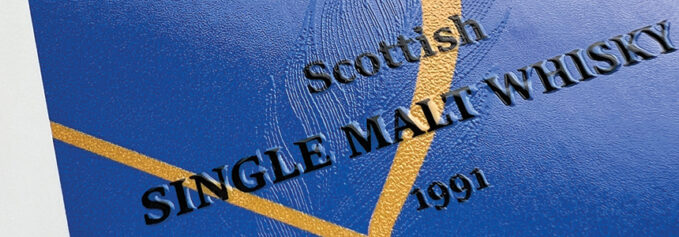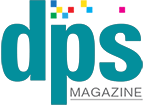
by Cassandra Balentine
Automation and sustainability top the list of demands for many print producers in the label and packaging space. The solution is often found within digital print and supporting finishing technologies.
Above: Xaar’s Versatex technology adds varnish embellishments and variable data for premium label production.
In the next few years, Jason Koyama, advisor, production solutions, Canon U.S.A., Inc., expects continued growth in digital label production with a stronger emphasis on sustainability. “Automation and intelligent systems will play a key role in countering the pressures of a shrinking traditional label market, driving more efficient, eco-friendly production.”
Digital label production offers greater customization and effectiveness for shorter runs and applications requiring quick turnarounds. “Additionally, trends in packaging, ecommerce, increasing number of SKUs, as well as the need for personalized products will push the demand further beyond the next five years,” predicts Paul Albano, senior product manager, Toner Press Solutions, FUJIFILM North America Corporation, Graphic Communication Division.
“As digital print technology continues to evolve and replace analog machines, the possibilities for personalization and embellishments in labels will expand, allowing brands to meet the increasing consumer demand for products that feel as unique as they look,” comments Justin Noble, director of sales, Xaar.
In the coming years Kevin Davis, CEO, SnapPress, company of Allen Datagraph Systems, LLC, expects digital label production to focus heavily on sustainability, personalization, and technology integration.
Driving Trends
Automation, quality, sustainability, and added value are all factors driving digital adoption in the label space.
Juan Kim, CEO, Valloy Inc., says digital label production must fulfill the demand of real automation from prepress to finishing, similar to other industries like book manufacturing, textiles, and packaging. “The speed game has almost ended and now the key is to complete labels with a fully automatic process.”
Advancements in speed and automation allow digital printing to support faster, just-in-time production that enables brands to react quickly to trends and launch personalized products. “The result will be more efficient, flexible, and sustainable label solutions that align with evolving consumer expectations,” says Davis.
John Cusack, product line leader—inspection, color, registration, BW Converting, expects the evolution of digital label production to emphasize automation, precision, and high-speed efficiency. “With digital press systems in this space currently achieving speeds that exceed more than 400 feet per minute (fpm), the demand for robust inspection solutions that offer automated Delta-E color monitoring, barcode recognition, and dynamic learning will increase as converters look for ways to streamline quality control to match the pace of these recent advancements in press speeds. As standalone digital and hybrid press systems increasingly capture more traditional flexographic markets, sophisticated inspection solutions become vital in maintaining consistency and quality across end-use segments.”
Mike Pruitt, senior product manager, Epson America, Inc., expects digital label production to fill in all volume and print quality segments with presses that improve reliability and feature lower costs per label in the near future.
Sustainability needs are inherently addressed with digital print’s ability to print on demand. Additional advancements support a push for eco-friendliness.
“There’s a big demand from our customers for increased sustainability in their packaging, which includes digitally printed labels,” offers Jennifer Loegering, director of marketing, Primera Technology, Inc. “To meet this demand, the company is working with a number of pressure-sensitive materials suppliers to offer compostable and recyclable alternatives for labels, liners, and adhesives. At the same time, we’re working with ink companies to offer inks that are also compostable. They’re not here yet, but they’re in the labs being developed.”
Taylor Buckthorpe, director of sales and marketing, Colordyne Technologies, agrees, noting that sustainability focused innovations, including eco-friendly inks and recyclable substrates, align inkjet with brands’ environmental goals. Together, these developments make inkjet more adaptable, efficient, and environmentally responsible, meeting the market’s demands for flexibility and quality.
Digital print and finishing technologies also add value through personalization and embellishment.
Noble offers that textured and high-build print effects, varnishes, foils, and mass personalization all become available with Xaar’s Versatex Printbar, which can both be integrated with new machine configurations or retrofitted onto existing presses. “By enabling opacities of 85 percent at 50 meters per minute, the Versatex achieves brilliant whites and vibrant colors, producing eye-catching digitally printed labels that are comparable to screen print technology.”
Embellishments and tactile features and foils are easily added into labels “not only differentiating premium products on crowded shelves, but also strengthening brand identity and consumer engagement. Raised textures and high-build varnishes through to matte finishes and spot varnishes can all be printed in a single pass, meeting the demand for efficient production. In addition, the Versatex’s ability to jet high viscosity fluids improves the efficiency of digital label production as well as adding more functionality,” shares Noble.
Davis also notices a shift towards interactive packaging through augmented reality and smart labels, and the ability to produce highly customized designs on demand.
Machine Options
Digitalization of printing equipment continues to be a trend, and Michael Matthews, product manager – DP Color, Domino Printing Sciences, foresees a further increase in popularity going forward.
“Companies such as commercial printers and brand owners/in-plants show more interest in bringing label production in house and we will continue to see this expand,” shares Russell Doucette, product marketing manager, Konica Minolta Business Solutions U.S.A, Inc. “The ease of use and efficiency of these products enable companies to offer more services and products. Commercial printers who thought it was too expensive or complicated to expand into label production are seeing digital technology that is as easy to operate. As brand owners and in-plants assess and streamline their manufacturing processes, they will quickly notice the advantages of controlling often overlooked components (i.e. labels) to influence and improve their production lines. Just-in-time production offers companies the ability to move and pivot accordingly to meet market demands.”
Strides in inkjet are also making an impact on adoption. “Digital label production—particularly 1,200 dpi inkjet—will be a large part of label production in the next five years,” predicts Steve Lynn, director, labels and packaging, Durst Image Technology US LLC.
Lynn explains that at this level, inkjet delivers the required quality at high speeds and low cost to deliver short, medium, and long-run jobs effectively.
As digitization continues in the label space, James Thomas, head of sales and business development, Focus Label Machinery Ltd., sees the consolidation of machinery suppliers, smaller businesses being sold or merged with larger companies, ever shorter run lengths, and on demand production demands growing, all-inclusive click models from manufacturers becoming the norm—especially for basic reel-to-reel CMYKW equipment.
Digital label production continues to replace traditional analog print technologies to meet consumer demand for unique, tailored products. “As part of this step change, hybrid approaches increase as label producers look to add digital capabilities to existing presses to provide the personalization and embellishments on labels that are increasingly required,” says Noble.
Matthews predicts adoption of digital label printing technology to increase—with a particular interest in hybrid printing. “Hybrid printing enables converters to incorporate downstream coding or labelling at the label converting stage, reducing overall costs.”
Converters looking to maximize production capacity turn to hybrid lines to reduce changeover times between labels and inline RIP software to eliminate set-up delays, explains Matthews.
Beyond equipment, Matthews notes growing demand for cloud connectivity and data capture functionality, with businesses proactively inquiring after digital capabilities that provide actionable data insights. “Advanced data capture and cloud connectivity support in-depth analysis of production and consumption data—considering the print volume produced, time spent, and the resources consumed, which print providers can use to streamline production processes to run faster and more efficiently in the future.”
Facing New Challenges
While the advantages of digital and hybrid label production are attractive, challenges still hinder adoption.
Pruitt says the biggest issues he sees today include the high capital expense for reliable digital label presses, as well as the lack of personnel to operate machines. “These go hand in hand as installing a digital label press represents a significant expense, not only in the machine itself, but also the related infrastructure required to support the new technology, including the cost of hiring additional, skilled employees to operate the press and offload the business with the expected increase of orders. Both factors—financial and operational—present challenges to the widespread adoption of digital label printing technologies.”
Another challenge is understanding the growing landscape.
With the amount of suppliers, Thomas admits that it’s difficult for companies not in the digital space to know where to purchase. Therefore it is important to understand how to sell digital to their markets in terms of return on investment, TCOP/TCOO, and determining that the lifetime associated costs and pricing work accordingly.
Buckthorpe states that digital printing in the label market faces challenges like high initial costs, material compatibility, and limitations with large-scale runs, “but ongoing innovations and industry efforts are steadily overcoming these obstacles, paving the way for broader adoption and greater flexibility.”
Additionally, keeping up with technology advancements and increasing complexity of data requires an initial expense and learning curve as employers will need to invest in up-skilling their workforce. “It should be noted that digital label printing is often less ideal for longer production runs, so this may affect adoption especially in environments where there are high-volume labeling needs,” says Albano.
Dario Urbinati, CEO, Gallus, points out that print providers today face a volatile market environment and companies are understandably conservative about making significant financial investments. “This is why it’s critical to invest in technology that is both flexible and agile, allowing for adjustments as market needs evolve.”
Cusack admits the transition from traditional flexographic production to producing labels on digital and/or hybrid presses can be challenging, especially for companies navigating a digital press installation for the first time. “The learning curve of migrating flexographic artwork files to digital can be a daunting given the intrinsic differences between analog and digital front-end processes.”
Video inspection systems are another tool to help ease this transition by simplifying job setup and reducing the technical learning curve associated with migrating from flexography to digital print technology. Addressing some of these operational challenges with accessible, automated inspection solutions will be key to broader adoption in the industry, shares Cusack.
Koyama admits it can be difficult to integrate next-generation technologies and business models in a way that complements existing workflows and methods. “Affordability and seamless integration remain crucial to driving wider adoption.”
Advancement Across the Board
Technology advancements address some of the challenges hindering the adoption of digital label printing.
In the entry-level space, which we loosely define as 1,000 labels per run for this article, ease of use and lower investment costs attract new investors.
“As digital printing technology continues to improve, equipment is becoming more affordable, thereby reducing the initial investment,” shares Albano.
Digital printers are engineered with longer lasting components, higher supply yields, and easier maintenance to help reduce overall costs. “These advancements make digital label printing more accessible, efficient, and cost effective, helping to overcome some of the key challenges in this segment of the market,” says Albano.
“Larger printer manufacturers, including Epson, have high-quality printheads that are increasingly becoming available to this market segment. With the adoption of high-quality printheads, manufacturers are able to increase reliability and print quality while driving down end user costs,” offers Pruitt.
Ben Luly, product manager, Mark Andy, points out that the entry-level market also demands workflow automation at all levels, along with easier-to-use solutions to produce high-quality products at fast turnarounds.
Davis says SnapPress helps label businesses optimize short runs, reduce waste, and limit labor needs with user-friendly operations. “By providing smaller, customized print runs, it allows commercial printers to stay profitable with low-volume orders, making small production feasible and financially attractive. This is crucial as brands move to short-run labels that meet consumer preferences and regulatory standards.”
For mid- to high-volume label production environments—nearing 10,000 labels per run—print quality and color consistency are increasingly important.
Thomas says new inks for packaging using LED-UV support growth in this space, along with faster speeds of up to 100 meters per minute.
Manufacturers are working to bring equipment costs down while simultaneously advancing software solutions, making it easier to support versioning and automate jobs that advance web to print orders for mid-level label providers, offers Pruitt.
Koyama explains that advancements in automation, enhanced ease of use, affordability, and sustainability address challenges in mid- and mid-to-high volume environments, and are factors helping businesses achieve better productivity, lower costs, and improved environmental outcomes.
As we go further up the volume chain, targeting lengths of over 10,000 labels per run, Pruitt believes it is all about keeping the printheads healthy. “If the printheads are clear and the press is operating according to manufacturer directions, then web breaks and electronic failures seldom happen. Manufacturers provide techniques and software solutions, such as redundant nozzles and compensating for failed nozzles, that are maturing as well to support the reliability of the printhead, inks, and ink conditioning systems on digital presses.”
Luly says this end of the market is more competitive, creating the need for more efficient solutions, along with the need for data acquisition to maximize facility profits.
Buckthorpe adds that advancements in inkjet technology address key challenges in the narrow web label market through improved ink formulations for diverse materials, faster printheads, and UV-LED curing for higher speeds, and enhanced color management for consistent quality. Integrated finishing options, such as inline varnishing and foiling, streamline production by enabling single-pass, high-value label creation.
Matthews sees machine vision inspection technology becoming key to winning new business and retaining existing customers’ trust, providing the reassurance that every label meets the highest quality standards, and every code printed can be read successfully throughout a product’s lifetime.
Advancements in inspection technology address challenges in higher volume label runs by integrating automated inspection with minimal manual intervention. Automated Delta-E color monitoring ensures consistent color accuracy, while the dynamic learning feature of these systems minimizes false defect detection. “These systems’ real-time defect mapping allows operators to monitor and address any variations immediately, preventing issues from recurring across run sizes. These innovations enhance production efficiency while maintaining the high-quality standards expected in this segment,” offers Cusack.
Next-Level Labels
In the next few years, digital label production is expected to significantly evolve with advancements in customization, sustainability, and automation.
Buckthorpe says these advancements allow brands to respond faster to market demands while reducing environmental impact. “Innovations in ink, finishing options, and digital integration will enable brands to create dynamic, engaging labels that stand out in a competitive market.”
Of course, transitioning to new technologies is not without its challenges. “Financial investment, staff training, and changes to workflows are common barriers to adopting innovations in label printing. Smaller printing companies in particular face difficulties in financing new equipment and justifying the expense if demand for shorter runs is uncertain. However, these same technologies present an opportunity to stand out in a crowded market,” adds Davis.
Jan2025, DPS Magazine



